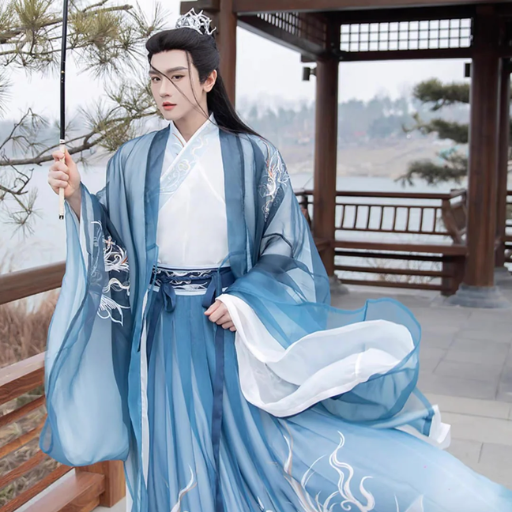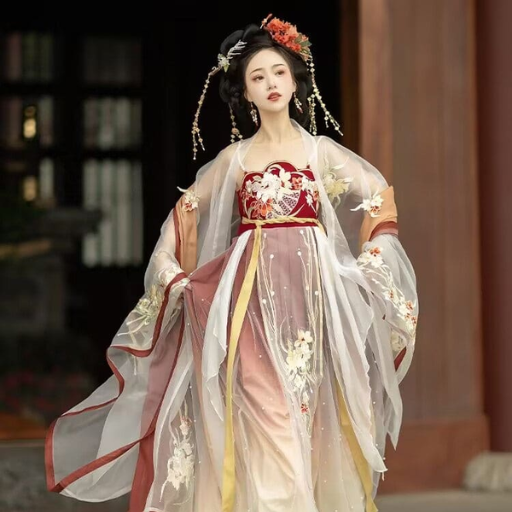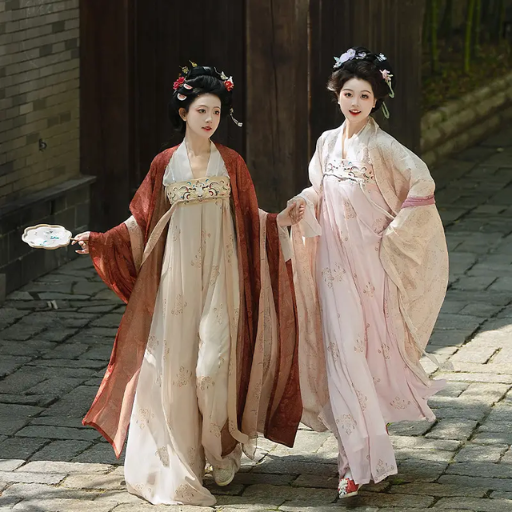Origins and History of Hanfu

Hanfu signifies the apparel of the Han people, representing traditional wear that has developed and transformed throughout a history spanning more than 4,000 years. The flowing long robes, wide sleeves, and cintura symbolized purity and modesty in ancient times. This traditional Chinese cultural garment evolved with several dynasties, adopting different styles and features that reflect the rich tapestry of Chinese civilization.
Years of History
Market Value (2021)
Enthusiasts (2023)
Annual Growth (2022)
Ancient Chinese Hanfu: A Historical Overview
Hanfu draws its roots from the Shang Dynasty (16th – 11th century BCE) and continued evolving across the Zhou, Han, Tang, and Ming dynasties, reflecting political, social, and cultural changes throughout time. The fabrics, styles, and adornments of Hanfu indicated social status and rank, with embroidery, colors, and patterns all serving as marks of dignity.
Evolution Through the Dynasties
Hanfu has undergone transformational changes over the centuries, with each Chinese dynasty contributing its unique political, cultural, and social influences to the garment’s development.
| Dynasty | Period | Key Characteristics | Notable Features |
|---|---|---|---|
| Han Dynasty | 206 BCE – 220 CE | Foundation of traditional Hanfu styles | Shenyi (long robe), broad flowing sleeves, Confucian simplicity |
| Tang Dynasty | 618 – 907 CE | Golden age of refinement and elaboration | Vibrant colors, intricate embroidery, Qixiong Ruqun, silk fabrics |
| Song Dynasty | 960 – 1279 CE | Return to austere, functional designs | Beizi (long straight robe), subtle patterns, Neo-Confucian influence |
| Ming Dynasty | 1368 – 1644 CE | Revival of Han identity and structured designs | Mamian skirts, elaborate embroidery, formal attire emphasis |
Tang Dynasty: The Golden Age
The Tang period (618–907 CE) is often identified as the golden age of Chinese culture, when Hanfu reached its highest degree of refinement. Garments featured vibrant colors, elaborate embroidery, and were typically made of silk with intricate patterns. The cultural exchange with Central Asia during this period influenced many Hanfu designs, creating a harmonious blend of foreign concepts with Chinese traditions.
Ming Dynasty: Revival and Structure
The Ming period (1368–1644 CE) marked a significant revival of Hanfu, emphasizing the restoration of Han identity after the Yuan Dynasty. This era introduced more structured robes, elaborate embroidery, and formal attire designed for various social occasions. Many of the designs from this period remain canonical in modern Hanfu fashion.
Cultural Significance of Hanfu

Hanfu holds deep cultural connotations relating to Chinese identity and heritage. With designs spanning more than 4,000 years, it represents the traditions, values, and artistic expression of various dynasties. Beyond historical significance, it serves as a way to preserve and celebrate Chinese culture in modern times.
Hanfu in Chinese Traditions and Festivals
Traditional Chinese festivals see ever-growing crowds donning Hanfu to honor culture and celebrate in traditional ways:
- Spring Festival: Celebrating the lunar new year with traditional elegance
- Mid-Autumn Festival: Honoring the harvest moon in classical attire
- Dragon Boat Festival: Commemorating cultural heritage through dress
- Hanfu Day: Annual celebration on the third day of the third lunar month
Symbolism of Identity and Heritage
Hanfu acts as a powerful symbol of identity and cultural heritage, resonating with millions who seek to reconnect with their cultural roots. Recent studies show that the Hanfu Movement grew by over 30% in 2023, indicating rising interest in traditional Chinese apparel and cultural identity.
RMB Market Revenue (2023)
Movement Growth (2023)
Styles and Designs of Hanfu

Hanfu encompasses a diverse collection of styles and designs, each representing different dynasties and periods in Chinese history. The main categories include:
Primary Hanfu Styles
Consisting of a blouse (Ru) and skirt (Qun), this versatile style suits various occasions and body types.
A one-piece robe-style garment that represents classical elegance and Confucian ideals.
A long coat, typically worn over other garments, was popular during the Song Dynasty.
Characteristics of Different Dynasty Styles
Tang Dynasty Hanfu (618–907 CE)
Tang Dynasty Hanfu features elegant, flowing fashions distinguished by broad sleeves, high-waisted skirts, and lengthy robes. The era’s prosperity is reflected in vibrant colors, including reds, golds, and blues, with silk as the preferred fabric. Women typically wore Ruqun with elaborately decorated accessories.
Ming Dynasty Hanfu (1368–1644 CE)
Ming Dynasty Hanfu represented a return to traditional Confucian values, featuring the Shenyi design with cross-collar construction. Embroidery often included auspicious symbols like dragons, peonies, or clouds, indicating prosperity and fortune.
Qing Dynasty Hanfu (1644–1912 CE)
The Qing period introduced Manchu-influenced styles while maintaining Han characteristics. Popular garments included Aoqun (jacket with skirt) and Changshan (long gown), featuring dense embroidery with metallic threads.
Modern Revival and Global Influence

The Hanfu revival movement has experienced extraordinary growth, driven by social media platforms, cultural festivals, and a renewed sense of cultural pride among younger generations worldwide.
Contemporary Market Growth
Market surveys in 2023 revealed that the Chinese Hanfu business has witnessed exponential growth:
- Market size exceeded 12 billion yuan (USD 1.65 billion)
- Annual growth rate of 30% in 2022
- Over 6 million enthusiasts by 2023
- Major brands are selling out collections within hours
Social Media Impact
Platforms like Douyin (TikTok), Xiaohongshu, and Weibo have played crucial roles in the revival:
- Billions of views on hashtags like #HanfuRevival
- International influencers collaborating with Chinese brands
- Fashion weeks in Paris and London featuring Hanfu-inspired designs
- Global appreciation reaching new audiences worldwide
Practical Tips for Wearing Hanfu
Select a Hanfu style that fits the occasion and your personal comfort. Different styles like Ruqun, Pao, or Shenyi offer unique characteristics suitable for various situations.
Ensure your Hanfu is well-fitted, especially around the collar and sleeves, for better comfort and an authentic appearance.
Choose specific undergarments that maintain the smooth flow and silhouette of the garment. Light, soft layers work best.
Learn proper tying methods for sashes and belts, as this significantly impacts the Hanfu’s appearance and comfort.
Select subtle accessories like hairpins or fans that complement rather than overwhelm the outfit.
Opt for traditional cloth shoes or simple flats to enhance the outfit’s authenticity while maintaining comfort.
Incorporating Hanfu into Modern Life
Recent trends show that over 70% of Chinese youth are willing to wear Hanfu for cultural expression or aesthetic purposes. Key approaches include:
- Daily Wear: Choose lightweight fabrics like cotton or linen for casual outings
- Cultural Events: Pair traditional Hanfu with classic accessories for festivals
- Special Occasions: Select silk or brocade fabrics for weddings and formal events
- Modern Adaptations: Incorporate Hanfu elements into contemporary fashion
Choosing Hanfu for Special Occasions

Selecting the appropriate Hanfu requires balancing tradition, style, and occasion-appropriateness. Recent trend analyses show dramatic increases in demand for elegant yet comfortable Hanfu, with “Hanfu wedding dress” searches rising by more than 35%.
| Occasion | Recommended Style | Fabric Choice | Color Scheme |
|---|---|---|---|
| Weddings | Ming Dynasty formal wear | Silk, Brocade | Red, Gold |
| Cultural Festivals | Tang Dynasty Ruqun | Chiffon, Cotton blends | Bright, festive colors |
| Formal Galas | Song Dynasty Beizi | Silk with embroidery | Deep blues, purples |
| Daily Wear | Modern adaptations | Cotton, Linen | Pastels, earth tones |
Frequently Asked Questions
The Future of Hanfu
The Hanfu revival represents more than a fashion trend—it’s a cultural renaissance that bridges ancient heritage with contemporary identity. As young generations embrace this traditional attire, they’re not only preserving history but actively participating in its evolution, ensuring that Chinese cultural heritage remains vibrant and relevant in our globalized world.
Reference Sources
- Boston University: China | Fashion
Talks about the composition of Hanfu, including the paofu robe, ru jacket, and qun skirt, and its cultural significance.
- Connecticut College: Power and Community in Traditional Chinese Dress
Explores the historical variations of Hanfu and its place in Chinese history.
- Columbia University: Unveiling the Male Side of Hanfu Fashion
Explores the historical importance of Hanfu for men and women, including its symbolism of social status.







